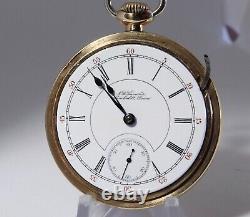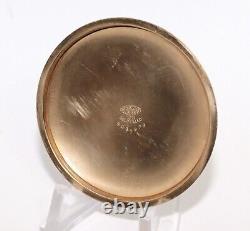
- Home
- Caseback
- Closure
- Ball Hamilton 999-b (2)
- Display Case (5)
- Double Half Hunter (2)
- Double Hunter (35)
- Full Hunter (109)
- Half Hunter (34)
- Hamilton 992 (5)
- Hamilton 992 Elinvar (2)
- Hamilton 992-b (16)
- Hunter (4)
- Hunting (5)
- Hunting Case (2)
- Open Face (2167)
- Open Face Case (4)
- Open Face Display (2)
- Screw Back And Bezel (3)
- Swing Out (2)
- Unknown (2)
- ... (3208)
- Department
- Indices
- Serial Number
- Vintage
Hamilton 930 Pocket Watch, 1897-Very Old, 18sz, 16J, Great Cond and Running Well








Hamilton 930 Pocket Watch, 1897-Very Old, 18sz, 16J, Great Cond and Running Well. This is a very interesting watch and one that you won't often find. This is a Hamilton Model 930 that was made in 1897 when Hamilton was only 3 years old. Hamilton would go on to make many million watches but this one was on #19941. Less than 20,000 Hamiltons in existence. This model is one of the only unadjusted watches that Hamilton ever made. Although it has many railroad attributes, it was not railroad grade as it was 16 Jewel. Hamilton kept superb records and we know a lot about this watch. I will try to post a link the original Hamilton records relating to this watch. You will need to cut & paste.
After 125 years it still looks good and runs very well... Front (bezel on), front (bezel off), back, inside case-back, stem and movement. Case: The case is an 18 size, gold-filled, open-face by Keystone/J.
They made very good cases and this one presents well. I may be wrong but I don't think that gold-filled cases appeared in 1897 so this case would probably be improper to this movement unless the movement sat, unsold for a number of years. In any event, there ARE extra case screw marks so this case is not original to the movement on that score as well. The case shows some even overall wear.There is some shallow coining on the bezel that is a bit worn. There is a tiny ding on the case body at 10. The back cover is engine-turned around an initial-shield that is unused.
The engraving also shows some even wear. I see some slight brassing along the edges of the case body (not visible in the photos). The crown (which gets the most wear by winding) is somewhat worn but has plenty of texture for winding, although the mainspring is somewhat hard towards the end. The bow is simple and shows some signs of chain-wear. The covers screw on and off easily and screw down without a gap.
I guess a proper case for a watch this old would be gold or silver as I do not think that Silveroid (Nickel). Was available back then either. Crystal: The crystal is glass with some slight bevel. It is clear and bright although I do see a light scuff near the center.
Not enough to show up in the photos. Dial: The dial is interesting. It is single-sunk, meaning that there is an area below the surface of the dial where the seconds-hand resides. Hamilton did make custom dials for jewelry shops and this dial is, no doubt, that. Hamilton did not sell directly to jewelers but through jobbers (wholesalers).
It is possible that this dial is original to the watch. The dial has Roman numerals and red five minute markets along the edge (a railroad feature). I see some light hairlines between the 3 & 4 and another between the 7 & 8.
The hairlines do appear in the photos if you look closely. There is a tiny chip right at the setting lever. The dial is bright white and the numbers are dark and clear. There is no sign of toning or fading. Hands: The hands are dark-cobalt, appearing almost black.I do not know if they are original to this movement or proper in time. Other watches, from the period seem to have more delicate hands. I see some light wear on the minute hand that does not appear in the photos.
Movement: The movement is really quite nice. It's plates are Nickel, bright and shiny.
The damaskeening is clear and very fancy. I see no stains or rust on this movement. There are some light maintenance scraches on the movement but nothing major or showing up in the photos. Lettering is black and is dark and intact.
Hamilton only made 4200 of this movement. Interestingly, although this watch was not railroad grade (16 jewels) it does have a bimetallic, compensating balance and a full regulator. The regulator is just shy of centered. Again, it's interesting that this movement was stem-wound and lever-set as required of railroad watches. I wonder why it had so many railroad attributes but Hamilton chose to make it not railroad-grade. The watch is running with strong action and keeping time. My notes indicate that the mainspring might not run a full 40 hours but I have not tested that. I serviced this watch in 2006. Since then it has resided in a safe. The synthetic oils that we used do not tend to dry-out or gunk-up like the older oils and this watch should continue to run for a good period. When I say a watch is running, I mean... Nothing could be more disappointing than receiving a watch that does not work. If you have a problem viewing it, message me and I'll provide a YouTube link. Each watch, more than likely has some special feature which attracted me when I acquired it for my personal collection.
